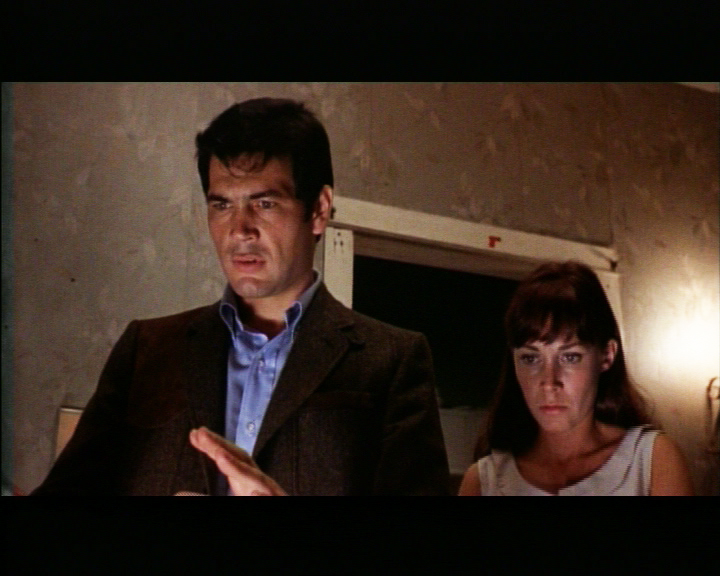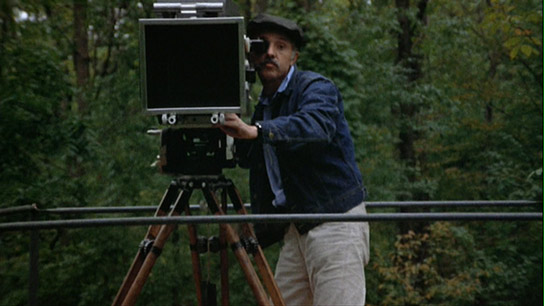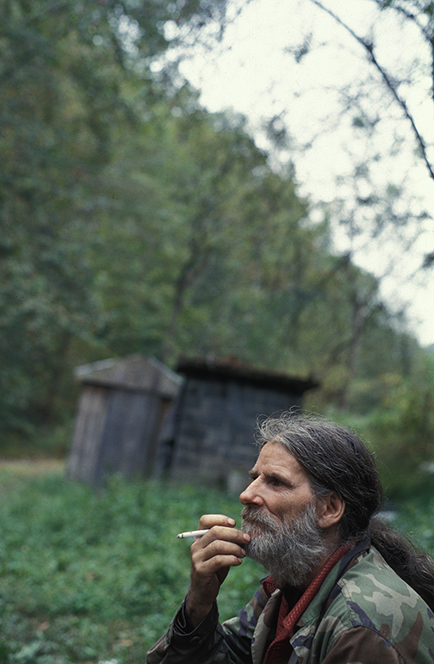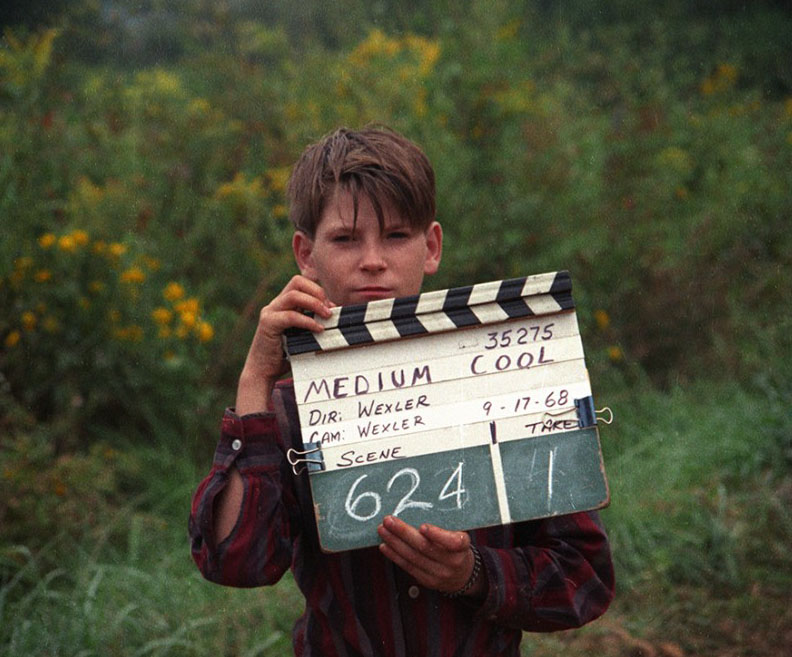Medium Cool
 “Look out Haskell, it’s real!” (2001,
“Look out Haskell, it’s real!” (2001,
re-edited 2015) details the production of 1969 feature film Medium Cool, written and directed by Haskell Wexler, alongside an exploration of historical events and conceptual ideas of the period. It features outtakes of Medium Cool and filmed interviews with its cast and crew, as well as commentators and historical figures. A version appears on the 2013 Criterion Collection DVD/Blu-ray release of Medium Cool alongside an audio commentary by Paul Cronin. Also included are extracts from Sooner or Later (2007), a rumination on memory and Appalachian fatalism, featuring Harold Blankenship, the young boy who appears in Medium Cool. The 2015 Eureka DVD/Blu-ray release includes a version of Sooner or Later and footage from 2013 of Haskell Wexler showing us the cameras he used to make Medium Cool.
The complete Sooner or Later, the short of Wexler and his cameras, the original 55-minute 2001 cut of “Look out Haskell, it’s real!” and the six-part 2015 version (c.380 minutes) are all here. The dialogue transcript of the 2015 version is here. Forthcoming is an accompanying book entitled Image-Making in the Sixties: Notes Towards an Understanding of Medium Cool. A piece of the 1968 trilogy.
Haskell Wexler’s Medium Cool – shot in 1968 and released the following year – is a complex film with a simple story. Wexler’s chief protagonist is John Cassellis, a punchy and insensitive Chicago television news cameraman (he calls an ambulance for an injured crash victim only after photographing her first) who appears oblivious to the responsibilities his profession entails, a man who proclaims to the world, “Jesus,
I love to shoot film.” But when Cassellis discovers that his boss has been showing the station’s outtakes to the FBI, he expresses genuine disgust and is promptly fired. Cassellis, in the meantime, has befriended the pigeon-obsessed Harold, a young boy newly arrived in the city from Appalachian West Virginia, and eventually falls for Harold’s mother Eileen, whose husband has died in Vietnam. When Harold goes missing one evening, the film’s memorable climax has Eileen scrambling through crowds of protestors and police at Chicago’s Democratic National Convention, as she searches for her boy.
Medium Cool‘s plot might seem at best contrived, at worst simplistic and hackneyed, but after a look at how, where and when the film was made – ground-breaking as it was in its blending of documentary and traditional narrative techniques – and Wexler’s brainchild begins to shine out among most of Hollywood’s other efforts of the late 1960s. Medium Cool seems to cause more confusion today than it did when first released because contemporary cinema-goers, acclimatized to the array of digital effects at filmmakers’ fingertips, can’t believe that a director would ask his actors to wade into real riots where real police were waving real nightsticks just so he could get the shots he wanted. In using as the backdrop to his fictional work the political and social upheavals shaking America in 1968, this is exactly what Haskell Wexler did.
In an interview from 1969 Wexler suggested that films “don’t have to be made behind big thick walls with hundred-man crews. Films only need a few people with a good idea.” Though today best known for his Academy Award-winning cinematography of Hollywood films such as Who’s Afraid of Virginia Woolf, In the Heat of the Night, Bound for Glory and Coming Home, Wexler is also one of America’s finest unsung documentarians, a filmmaker who, since the early 1960s has produced a series of fascinating, politically impassioned non-fictions that have chronicled key episodes of post-war America. The Bus was filmed at the 1963 March on Washington where Martin Luther King Jr. gave his “I have a dream” speech, and ten years later in Vietnam Wexler shot Introduction to the Enemy with Jane Fonda and Tom Hayden. In 1975, he and Emile de Antonio were asked by the radical protest group the Weather Underground to make Underground (subpoenaed by the US government) and his 2000 documentary Bus Rider’s Union was acclaimed internationally. A long-standing collaboration with Saul Landau yielded a number of films over the years, and most recently Wexler has campaigned against long hours on film sets with Who Needs Sleep. In 1968, yearning to make a fictional feature, Wexler stated that he wanted to “find some wedding between features and cinéma-vérité. I have very strong opinions about us and the world, and don’t know how in hell to put them all in one basket.”
By late 1967, Wexler started writing a feature-length script based on The Concrete Wilderness, a novel by Jack Couffer. “Paramount offered me Couffer’s book, a property they’d had on their books for a while,” Wexler explains. “At the time I felt certain that Couffer’s novel was not the sort of film I could make in good conscience with all these momentous events going on in that vital election year of 1968, when there was still some hope that there might emerge within the Democratic Party a viable candidate who would come out against President Johnson’s waging of the war in Vietnam. I was active in the anti-war movement and I knew – like many – that the Democratic National Convention, due to be held in Chicago in August 1968, was going to be the focal point for our protests, so I junked most of the book’s plot and wrote a script about a cameraman and his experiences in the city that summer. I also knew I wanted to film in the Uptown community of Chicago, where the Appalachian immigrants lived, and wrote a story about how he falls for a young Vietnam widow.”

1968, as it happened, quickly turned into America’s annus horribilis. In January the Tet Offensive was launched, with North Vietnamese forces overrunning major American military and diplomatic bases. In March, President Johnson, having failed to grasp the huge anti-war sentiment developing in the country, announced he would not run as a candidate for his party in the election later that year. In April, Martin Luther King Jr. was assassinated in Memphis, resulting in destructive rioting in many of America’s cities, including Washington and New York, and two months later Robert Kennedy, the leading anti-war Democrat, was also murdered.
Aspiring to bridge the gap between narrative and documentary filmmaking, Wexler decided to weave the events that were causing such profound political and social upheaval into his fictional tale. “Kennedy was killed a couple of weeks before we were due to start shooting, so I got a small crew together along with my two principal actors and we all went to the funeral in Washington, D.C. to shoot scenes that I thought would have a use in the final film, at that point still called The Concrete Wilderness. We also went to watch the Illinois National Guard who were preparing for the expected troubles in Chicago later that summer, and got some great footage of them training. The troops were split into two sides. Groups from each unit would dress up as hippies and protesters while the rest of the soldiers would be instructed in how to deal with these so-called deviants.”
Wexler’s first draft screenplay even contained scenes of protests and disturbances at the Chicago Convention that hadn’t even taken place yet. “Of course the script didn’t specify exact shots,” Wexler explains, “but we all knew months before that there would be clashes between the protesters and the establishment. What surprised us all more than anything was the extent of those clashes. For my film I had planned to hire extras and dress them up as Chicago policemen, but in the end Mayor Richard Daley provided us with all the extras we needed.” Wexler threw Verna Bloom into what the official report was later to call “police riots” in the streets around the Convention Hall, and though she made her way through the battered and bloodied crowds without mishap, Wexler and his crew were tear-gassed. As the gas comes flying toward the camera, a voice on the soundtrack exclaims “Look out Haskell, it’s real!”
“I was out of action for a day and a half. I have to admit that the line ‘Look out Haskell, it’s real!’ was put in afterwards,” says Wexler. “That’s actually my son speaking the line, recorded months later, because we weren’t taking sound at that stage. It wasn’t possible for the sound recordist Chris Newman to follow me around every minute. But if someone had read my mind the moment I saw that teargas coming toward the camera they would have heard me speak those lines. I’ve always felt quite invincible behind a camera but that gas was definitely a strong enough jab from the so-called real world to remind me that the glass with the etched 1:1.85 is no barrier to your lungs and your eyes.” As Paul Golding, Medium Cool‘s editor, has remarked, “The line made a really important point about the wonderful dichotomy that the film sits on, that razor edge of what’s real and what’s not real, what’s fiction and what’s fact. All those issues that the film tried to raise were nicely crystallized for that one line so of course we used it, even though it was fake.”
 Though Medium Cool is very much of its era, the film remains a vibrant and exciting work less dated than many other studio productions of the era, a skillful synthesis of fact and fiction, one of the most coherent political feature films ever released by a Hollywood studio. Suffused with the techniques of figures like John Cassavetes (originally slated to play the leading role) and Jean-Luc Godard (the final shot of the film is a direct homage to Godard’s surprise ending of
Though Medium Cool is very much of its era, the film remains a vibrant and exciting work less dated than many other studio productions of the era, a skillful synthesis of fact and fiction, one of the most coherent political feature films ever released by a Hollywood studio. Suffused with the techniques of figures like John Cassavetes (originally slated to play the leading role) and Jean-Luc Godard (the final shot of the film is a direct homage to Godard’s surprise ending of
Le Mépris), and rooted in the ideas of media theorist Marshall McLuhan (whether or not Wexler was conscious of such things at the time), the film is a unique piece of cinema. Yet in 1969 Paramount was so shocked at what Wexler delivered to them for release that they sat on the finished film for months, wondering whether they could distribute it at all. “They put all kinds of obstacles in its path,” explains Wexler. “The executives told me that I had to have releases from all the people in the park sequences, and then said that if people saw this film and then committed some violent act the officers of Paramount could be personally liable. Of course they also objected to the language and the nudity, things which ultimately meant the film received an X-rating. What no one had the nerve to say was that it was a political X.”
Wexler was not being immodest back in 1969 when he said he felt there was “much to be gained by filming in and among people who feel things strongly. If your film can reflect areas of life where people feel passion, then it will have genuine drama. I sincerely believe we have accomplished this in Medium Cool.” The film has been tremendously influential, and as Wexler happily notes, “I can’t go anywhere in the world without someone telling me how important the film was for them back then.” Writer-director John Sayles (for whom Wexler shot several films, including Matewan) feels that “In my thinking about how to present a story, Haskell’s film has been a strong guide. Though my films are very planned and written, during the shooting I attempt to make them as ‘found’ as possible, always reminding the actors that they don’t know what’s going to happen next. That’s certainly something the documentary style of Medium Cool set me on a path to.” And as director Andrew Davis explains, “My whole style of lighting and freedom of improvisation is all based on my work as an assistant cameraman on Medium Cool. The most obvious connection to this is the St. Patrick’s Day Parade scene in The Fugitive, where I threw Harrison Ford and Tommy Lee Jones out into the crowds with a couple of cameras.”
Haskell Wexler has fought many battles throughout his career, committed as he is to his own personal projects while at the same time continuing to work at the heart of the Hollywood establishment. Much of the vitality of Medium Cool – Wexler’s 1968 state of the nation speech – stems from the film’s allegorical narrative with the autobiographical lead character demonstrating just how difficult it is to work within the system and retain even a semblance of dignity, a system (and maybe even profession) that corrupts and co-opts even the highest-minded of individuals. “When I was in Vietnam with Jane Fonda,” says Wexler, “I was filming a farmer walking through a field, when all of a sudden he stepped on a land mine. Two Vietnamese guys ran out there to help him and I ran after them to shoot the scene of them bringing this guy in, his legs all bloody. The whole time I had two overwhelming feelings. One was ‘I got a great shot!’ and the other was to put my camera down and help the farmer. In the end I carried on filming even though I couldn’t even see what I was shooting because I was crying so hard. I have thought about that moment many times, about the question of when you have to put the camera down, when to stop observing and get involved.”
“Look at the first scene of Medium Cool, with Cassellis filming the injured woman before he even calls the emergency services. Artists and craftsmen have to ask of themselves how much of their life is just doing the job, keeping in focus and keeping the scene lit well, and how much of being an artist involves a responsibility to your own ethical beliefs. I believe that because of our ability to influence others we do have a responsibility beyond just doing our job, and because I made Medium Cool it doesn’t absolve me of the guilt I am accusing us all of, the guilt of not recognizing individual responsibility for social ills. As a filmmaker I’m guilty of the same insensitivity, but with this film I am throwing that challenge back at the audience. I know that’s a lot of baggage to expect from a goddamned movie which basically stole its whole structure from Jean-Luc Godard, but these ideas were very much a part of my life back then, and still are.”
A version of this essay appears in the September 2001 issue Sight and Sound (PDF here). A short piece about the ending of Medium Cool, published in Sight and Sound, is here.
